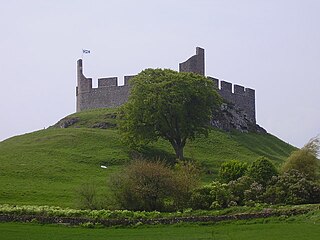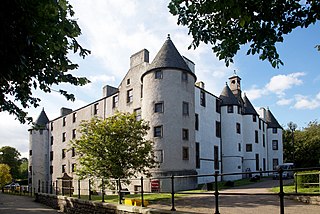Related Research Articles

Thomas Hamilton, 1st Earl of Haddington, designated before his peerage as 'of Drumcarny, Monkland, and Binning', was a Scottish administrator, Lord Advocate, judge, and Lord Lieutenant of Haddingtonshire.
Robert Ker, 1st Earl of Roxburghe was a Scottish nobleman.
William Ruthven, 2nd Lord Ruthven was a Scottish nobleman. He served as an Extraordinary Lord of Session and Keeper of the Privy Seal.

Clan Home is a Scottish clan. It held immense power for much of the Middle Ages and dominated the eastern Scottish Borders. It produced no fewer than eight Wardens of the Eastern March – more than any other family.

Hume Castle is the heavily modified remnants of a late 12th- or early 13th-century castle of enceinte held by the powerful Hume or Home family, Wardens of the Eastern March who became successively the Lords Home and the Earls of Home. The village of Hume is located between Greenlaw and Kelso, two miles north of the village of Stichill, in Berwickshire, Scotland.. It is a Scheduled Ancient Monument, recorded as such by Historic Environment Scotland.
Sir Alexander Home of that Ilk, 1st Lord Home was in 1448 Sheriff Deputy for Berwickshire, and was made a Lord of Parliament on 2 August 1473. He is an ancestor of the Earls of Home.
Alexander Home, 1st Earl of Home and 6th Lord Home, was a Scottish nobleman and Lord Warden-general of all the March. He succeeded as the 6th Lord Home, a Lord of Parliament in the Peerage of Scotland, in 1575, and he was created Earl of Home in the Peerage of Scotland in 1605.
Hugh Montgomerie, 1st Earl of Eglinton was a Scottish peer.
Sir Patrick Hume, of Polwarth and Redbraes was a Scottish landowner, courtier and makar.
Mariotta or Maryon or Marion Haliburton, Lady Home was a 16th-century Scottish noblewoman. She varied the spelling of her forename between Mariotta, Marion, and Mary. She is remembered for her defence and negotiation of the surrender of Hume Castle after the Battle of Pinkie when the castle was surrounded by an English army. Afterwards she continued to struggle for the rights of her people at the village of Hume in the Scottish Borders, writing both to the English commander and the Scottish leader.
Alexander Home, 5th Lord Home was a Scottish nobleman and Warden of the Eastern March.

Sir Robert Logan of Restalrig was a Scottish knight who was allegedly involved in the Gowrie House affair of 1600.
Alexander Home, 3rd Lord Home was a Scottish soldier and nobleman, Chamberlain of Scotland and Warden of the Eastern March. He fought at the Battle of Flodden where his forces defeated the English right wing before the Scottish army was destroyed. After the battle, he resisted the regency of John Stewart, Duke of Albany and was captured and executed for rebellion.
Lord Haliburton of Dirleton was a Scottish Lordship of Parliament created circa. 1450 for Sir Walter de Haliburton, Lord High Treasurer of Scotland. The seat of Lord Haliburton was at Dirleton Castle in present-day East Lothian.
George Haliburton, 4th Lord Haliburton of Dirleton, was a Scottish Lord of Parliament.

Alexander Erskine of Gogar was a Scottish landowner and keeper of James VI of Scotland at Stirling Castle.
Mary (Dudley) Sutton, Countess of Home (1586–1644), was a landowner, living in England and Scotland.

James Hay, 7th Lord Hay of Yester (1564-1609) was a Scottish landowner and courtier.

James Scrimgeour Scottish landowner and Constable of Dundee.
James Home of Coldenknowes was a Scottish landowner, soldier, and keeper of Edinburgh Castle.
References
- . Dictionary of National Biography . London: Smith, Elder & Co. 1885–1900.